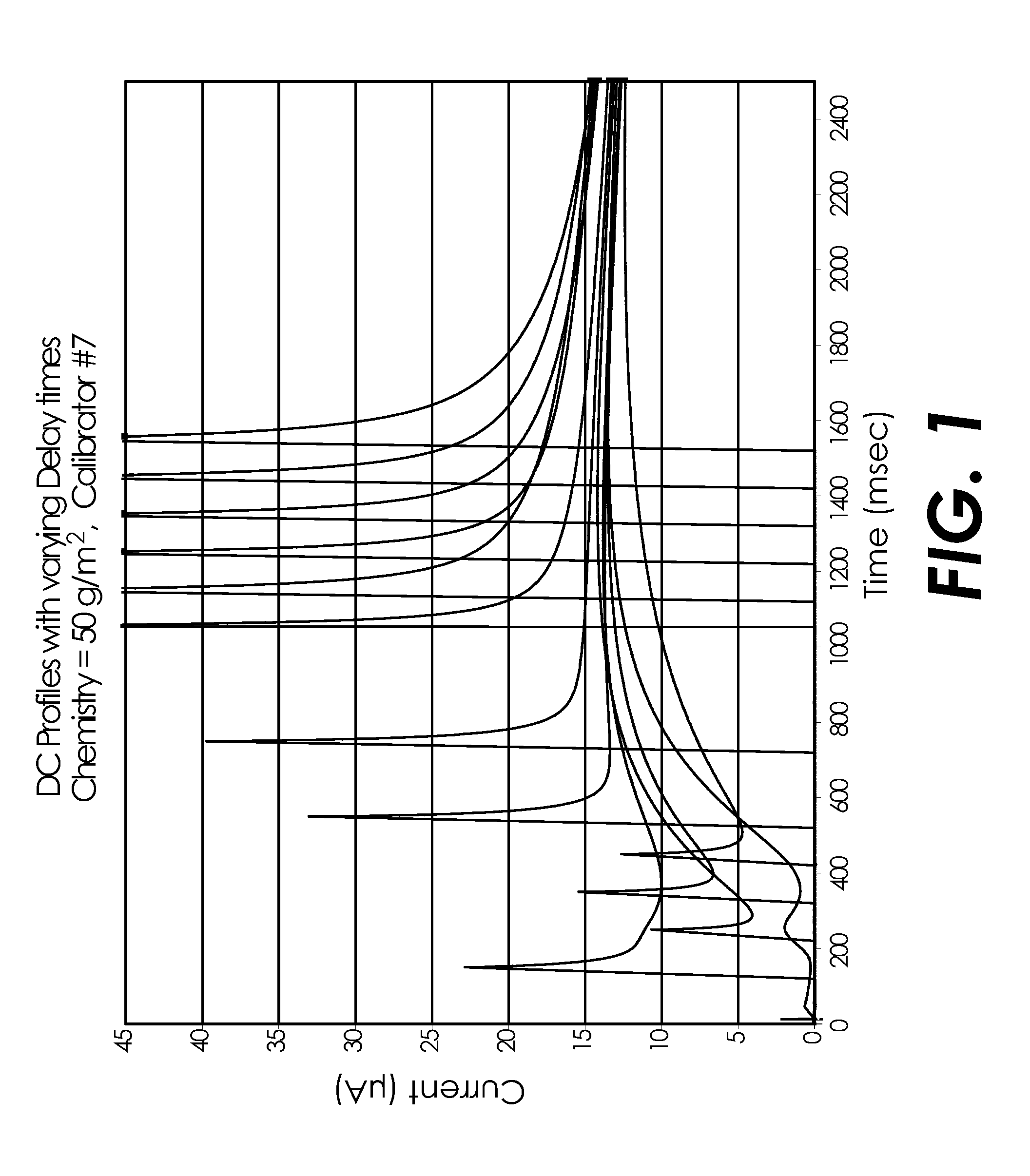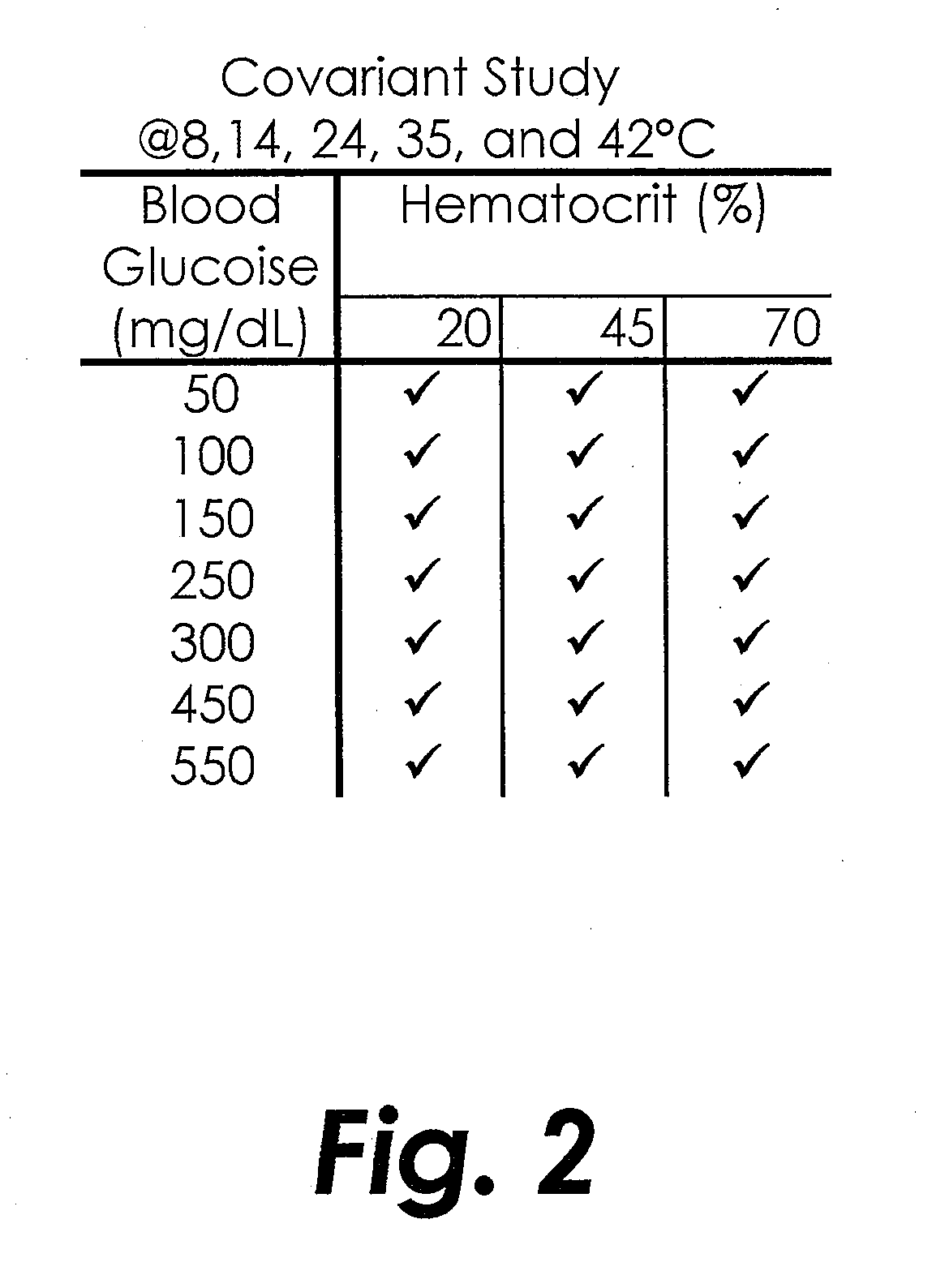System and method for determining the concentration of an analyte in a sample fluid
a technology of fluid concentration and electrochemical method, which is applied in the direction of material electrochemical variables, instruments, and investigating phase/state change, etc., can solve the problem that the true utility of a short test time is not fully reached with these teachings, and the electrochemical method for measuring the concentration of a chemical in blood is not fully applied. to achieve the effect of reducing the time for completing applications
- Summary
- Abstract
- Description
- Claims
- Application Information
AI Technical Summary
Benefits of technology
Problems solved by technology
Method used
Image
Examples
example 1
Sequential Multiple AC Frequency Test with Fast Total Test Time
[0073]U.S. Pat. No. 7,407,811 teaches use of sequentially applied multiple frequency AC blocks followed by a DC block. For example, Example 5 described in U.S. Pat. No. 7,407,811 utilizes sequential applications of AC excitation followed by a DC excitation. The excitation signal comprised a 10 kHz AC signal applied for approximately 1.8 seconds, a 20 kHz AC signal applied for approximately 0.2 seconds, a 2 kHz AC signal applied for approximately 0.2 seconds, a 1 kHz AC signal applied for approximately 0.2 seconds, and a DC signal applied for approximately 0.5 seconds. The Total Test Time was 3.0 seconds.
[0074]In Example 6 of that same patent, it was desired to obtain Total Test Times as low as 1.1 seconds using the same test strip design that was used for Example 5 in that patent. In order to achieve this, the inventors did not believe that they could simply apply the sequential excitations of Example 5 for shorter perio...
example 2
Sequential Multiple AC Frequency Test with Fast Total Test Time and Varying Reagent Thickness
[0113]A covariate study testing multiple whole blood samples for glucose concentration was performed using the electrode and testing structures similar to the ACCU-CHEK® AVIVA™ biosensor available from Roche Diagnostics, Inc. of Indianapolis, Ind. USA. A pyrroloquinoline quinone dependent glucose dehydrogenase (PQQ-GDH) based reagent with the same or substantially similar formulation from Table 1 (above) was applied to the biosensors in one of three thicknesses: 2 μm, 2.5 μm and 4 μm. A covariate study was performed with whole blood samples similar to Example 1 but with six glucose concentrations, five hematocrit levels, and five temperatures, as detailed in FIG. 10.
[0114]The AC excitation potentials for this Example 2 were applied sequentially as detailed in FIG. 11. A 10 kHz dose detection and sample sufficiency method (not shown) was followed by a 300 ms 20 kHz signal followed by 100 ms a...
example 3
Multi-Frequency AC Test with Fast Total Test Time
[0149]The measurements conducted for Example 3 were made with electrode structures similar to that of ACCU-CHEK® AVIVA™ biosensors and reagents the same or similar to the formulation set forth in Table 1 (above). These sensors were fabricated using generally the same technology as ACCU-CHEK® AVIVA™ biosensors using a combination of processes including sputtering, laser ablation, reagent slot die coating, and lamination.
[0150]The measurement sequence consisted of three basic blocks. The first measurement block (not shown) utilized a 10240 Hz sine wave excitation applied to the test strips in order to detect sample dose sufficiency (filling of the capillary test chamber sufficient to conduct a measurement). The use of AC measurements for drop detect and dose sufficiency is described in U.S. Pat. No. 7,597,793, referred to hereinabove.
[0151]After sufficient sample was detected, the second measurement block was begun using a multi-sine (a...
PUM
| Property | Measurement | Unit |
|---|---|---|
| total time | aaaaa | aaaaa |
| frequencies | aaaaa | aaaaa |
| frequencies | aaaaa | aaaaa |
Abstract
Description
Claims
Application Information
 Login to View More
Login to View More - R&D
- Intellectual Property
- Life Sciences
- Materials
- Tech Scout
- Unparalleled Data Quality
- Higher Quality Content
- 60% Fewer Hallucinations
Browse by: Latest US Patents, China's latest patents, Technical Efficacy Thesaurus, Application Domain, Technology Topic, Popular Technical Reports.
© 2025 PatSnap. All rights reserved.Legal|Privacy policy|Modern Slavery Act Transparency Statement|Sitemap|About US| Contact US: help@patsnap.com



